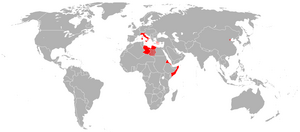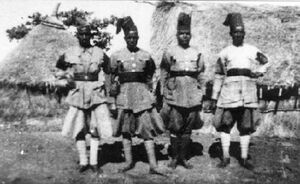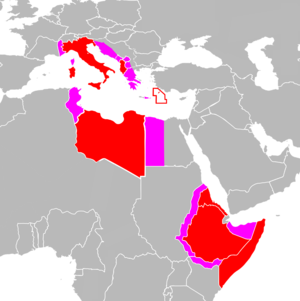الإمبراطورية الإيطالية
Italian Empire | |
|---|---|
| 1882–1960 | |
 الأخضر: مملكة إيطاليا الليموني: المستعمرات/الممتلكات الإيطالية الرمادي الداكن: الأراضي التي تحتها إيطاليا ومحمياتها | |
| المكانة | Colonial empire |
| King | |
• 1869–1878 | Victor Emmanuel II |
• 1878–1900 | Umberto I |
• 1900–1946 | Victor Emmanuel III |
• 1946 | Umberto II |
| التاريخ | |
| 1869 | |
| 1882 | |
| 1887–1889 | |
| 1889 | |
| 1899–1901 | |
| 1911–1912 | |
| 1917–1920 | |
| 1923–1932 | |
| 1947 | |
| 1950–1960 | |
| Area | |
• Total | 3,775,294 km2 (1,457,649 sq mi) |
| 1938[1] | 3,798,000 km2 (1,466,000 sq mi) |
| 1941[2] | [convert: invalid number] |
| جزء من سلسلة عن |
| تاريخ إيطاليا |
|---|
 |
| التاريخ القديم |
| إيطاليا ما قبل التاريخ |
| الحضارة الإتروسكية (12م–6م. ق.م) |
| ماگنا گريشيا (ق. 8–7 ق.م.) |
| روما القديمة (ق. 8 ق.م.–5 م) |
| سيطرة القوط الشرقيين (القرون 5-6 ) |
| العصور الوسطى |
| إيطاليا في العصور الوسطى |
| اعادة فتح البيزنطيين لإيطاليا (قرون 6 -8) |
| سيطرة اللومبارد (6 –8 ح.) |
| الامبراطوريتان الكارولنجية والرومانية المقدسة |
| الإسلام والنورمان في جنوب إيطاليا |
| الجمهوريات البحرية والمدن-الدول الإيطالية |
| العصر الحديث المبكر |
| النهضة الإيطالية (ق. 14 –16) |
| الحروب الإيطالية (1494–1559) |
| السيطرة الأجنبية (1559–1814) |
| توحيد إيطاليا (1815–1861) |
| التاريخ الحديث |
| الملكية (1861–1945) |
| إيطاليا في ح.ع.1 (1914–1918) |
| الفاشية والامبراطورية الاستعمارية (1918–1945) |
| إيطاليا في ح.ع.2 (1940–1945) |
| الجمهورية (1945–الآن) |
| سنوات الرصاص (عقدا 1970–1980) |
| موضوعات |
| الدول التاريخية |
| التاريخ العسكري |
| التاريخ الاقتصادي |
| التاريخ الجيني |
| تاريخ المواطنة |
| تاريخ الموضة |
| التاريخ البريدي |
| تاريخ السكك الحديدية |
| تاريخ العملة |
|
|
برزت الإمبراطورية الاستعمارية الإيطالية (بالإيطالية: Impero Coloniale Italiano) بعد ولادة مملكة إيطاليا وانضمت إلى الدول الأوروبية الأخرى في إنشاء المستعمرات في خارج أوروبا خلال التدافع "من أجل أفريقيا". يعود تاريخ إيطاليا كدولة موحدة إلى عام 1861. بحلول ذلك الوقت بنت فرنسا وإسبانيا والبرتغال وبريطانيا وهولندا إمبراطوريات كبيرة على مر مئات من السنين. كانت أراضي الدولة العثمانية آخر ما تبقى من مناطق مفتوحة للاستعمار في القارة الأفريقية. بسبب اندلاع الحرب العالمية الأولى في عام 1914 ضمت إيطاليا اريتريا والصومال وانتزعت السيطرة على أجزاء من الامبراطورية العثمانية بما في ذلك ليبيا على الرغم من هزيمتها في سعيها للتغلب على إثيوبيا. سعت الحكومة الفاشية الإيطالية بقيادة الديكتاتور بينيتو موسوليني الذي وصل إلى السلطة في عام 1922 إلى زيادة حجم الإمبراطورية مرة أخرى وهو ما حدث عن طريق القوة أو بالتهديد باستخدامها. نجح في ضم إثيوبيا بعد أربعة عقود من الفشل السابق وجرى توسيع حدود إيطاليا في أوروبا على حساب جيرانها. أعلنت "الإمبراطورية الإيطالية" رسمياً يوم 9 مايو/ أيار 1936 بعد احتلال إثيوبيا.[3] اصطفت إيطاليا بجانب ألمانيا النازية خلال الحرب العالمية الثانية وتمتعت في البداية بنجاحات. رغم ذلك نجحت قوات الحلفاء في السيطرة على المستعمرات الإيطالية في الخارج وعندما تم غزو إيطاليا نفسها عام 1943 لم يعد للإمبراطورية وجود.
. . . . . . . . . . . . . . . . . . . . . . . . . . . . . . . . . . . . . . . . . . . . . . . . . . . . . . . . . . . . . . . . . . . . . . . . . . . . . . . . . . . . . . . . . . . . . . . . . . . . . . . . . . . . . . . . . . . . . . . . . . . . . . . . . . . . . . . . . . . . . . . . . . . . . . . . . . . . . . . . . . . . . . . .
History
Background and pre-unification era
Imperialism in Italy dates back to ancient Rome, and the Latin notion of mare nostrum ("Our Sea", referring to the Mediterranean) has historically been the basis for Italian imperialism, especially during the fascist era.[4] During the Middle Ages and the modern period, the Republic of Venice and the Republic of Genoa controlled networks of "colonies" in the Mediterranean region known as the Venetian Empire and the Genoese Empire respectively. Between the 15th and 16th centuries, Italian explorers contributed to the colonial enterprises of other European countries in the Americas: Cristopher Columbus from Genoa served Spain, Amerigo Vespucci from Florence served Portugal, the Cabot brothers from Venice served England, and Giovanni da Verrazzano from Florence served France. However, no Italian power took an active role in the scramble for the Americas, with the notable exception of the Pope who acted as an arbiter between European colonial powers during the Renaissance. The geographical position of Italy, located in the center of an internal sea, without an open free access to the ocean, contributed to this purely Mediterranean policy. Ferdinand I, Grand Duke of Tuscany, made the only Italian attempt to create a colony in the Americas, in what is now French Guiana, organizing in 1608 an expedition to explore the north of Brazil and the Amazon river in 1608 under the command of the English captain Robert Thornton. However, Thornton, on his return from the preparatory expedition in 1609, found Ferdinand I dead and his successor, Cosimo II, was not interested in the project. In 1651, Giovanni Paolo Lascaris, Italian nobleman and Grand Master of the Knights Hospitaller of Malta (at the time a vassal state of the Kingdom of Sicily), possessed four Caribbean islands: Saint Christopher, Saint Martin, Saint Barthélemy, and Saint Croix, which were colonized from 1651 until 1665.[5][6] No other colonial attempt in the ocean was made and, by 1797, the Venetian and Genoese possessions in the Mediterranean were lost.
مولد الأمة والهروع إلى امبراطورية (1861–1914)

Once unified as a nation-state in the late 19th century, Italy intended to compete with the other European powers for the new age of European colonial expansion. It saw its interests in the Mediterranean and in the Horn of Africa, a region yet to be colonized and with access to the ocean. Italy had arrived late to the colonial race and its status as the least of the Great Powers, a position of relative weakness in international affairs, meant that it was dependent on the acquiescence of Britain, France and Germany towards its empire-building.[7] Italy had long considered the Ottoman province of Tunisia, where a large community of Tunisian Italians lived, within its economic sphere of influence. It did not consider annexing it until 1879, when it became apparent that Britain and Germany were encouraging France to add it to its colonial holdings in North Africa.[8] A last-minute offer by Italy to share Tunisia between the two countries was refused, and France, confident in German support, ordered its troops in from French Algeria, imposing a protectorate over Tunisia in May 1881 under the Treaty of Bardo.[9] The shock of the "Slap of Tunis", as it was referred to in the Italian press, and the sense of Italy's isolation in Europe, led it into signing the Triple Alliance in 1882 with Germany and Austria-Hungary.[10]

While attempts were made to buy the Nicobar Islands from Denmark in 1864 and 1865,[11] the genesis of the Italian colonial empire was the purchase in 1869 of Assab Bay on the Red Sea by an Italian navigation company which intended to establish a coaling station at the time the Suez Canal was being opened to navigation.[12] This was taken over by the Italian government in 1882, becoming modern Italy's first overseas territory.[13]
Italy's search for colonies continued until February 1885, when, by secret agreement with Britain, it annexed the port of Massawa in Eritrea on the Red Sea from the crumbling Egyptian Empire. Italian annexation of Massawa denied the Ethiopian Empire of Yohannes IV an outlet to the sea.[14] At the same time, Italy occupied territory on the south side of the horn of Africa, forming what would become Italian Somaliland.[15] However, Italy coveted Ethiopia itself and, in 1887, Italian Prime Minister Agostino Depretis ordered an invasion, leading to the Eritrea War. This invasion was halted after the loss of five hundred Italian troops at the Battle of Dogali.[16] Depretis's successor, Prime Minister Francesco Crispi signed the Treaty of Wuchale in 1889 with Menelik II, the new emperor. This treaty ceded Ethiopian territory around Massawa to Italy to form the colony of Italian Eritrea, and – at least, according to the Italian version of the treaty – made Ethiopia an Italian protectorate.[17] Relations between Italy and Menelik deteriorated over the next few years until the First Italo-Ethiopian War broke out in 1895, when Crispi ordered Italian troops into the country. Vastly outnumbered and poorly equipped,[18] the result was a decisive defeat for Italy at the hands of Ethiopian forces at the Battle of Adwa in 1896.[19] On Italy's side, the death toll was 6,889, including 4,133 Italians.[20] The Ethiopians suffered at least 4,000 dead and 10,000 wounded.[20][أ]
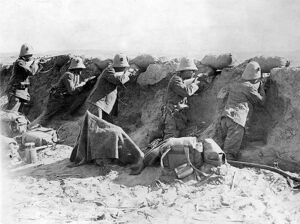
Italy also fought in the Mahdist War, and since 1890 it defeated Mahdist troops in the Battle of Serobeti and the First Battle of Agordat. In December 1893, Italian colonial troops and Mahdists fought again in the Second Battle of Agordat; Ahmed Ali campaigned against the Italian forces in eastern Sudan and led about 10–12,000 men east from Kassala, encountering 2,400 Italians and their Eritrean Ascaris commanded by Colonel Arimondi. The Italians won again, and the outcome of the battle constituted "the first decisive victory yet won by Europeans against the Sudanese revolutionaries".[21][صفحة مطلوبة] A year later, Italian colonial forces seized Kassala after the successful Battle of Kassala; Italy returned the city to the British at the end of the war three years later.
In 1898, in the wake of the acquisition of leased territories by Germany, Russia, Britain and France in China earlier that year, the Italian government, as a matter of national prestige and to assert Italy's great power status, demanded the cession of Sanmen Bay to serve as a coaling station. Aware that Italy did not have sufficient naval power in Asian waters to back up its demand, the Chinese imperial government rejected the ultimatum and all subsequent requests, arguing that Italy had no real political or economic interests in China. This national humiliation, which for Italy's main newspaper made the country appear "like a third or fourth-rate power", provoked the fall of the Italian government. This prompted Italy to take part in the international expedition in Beijing at the outbreak of the Boxer Rebellion the following year, and resulted in the acquisition of a concession in Tianjin in 1901, the only example of Italian colonialism in Asia.[22] [23] The concession was administered by the Italian consul in Tianjin.
A wave of nationalism that swept Italy at the turn of the 20th century led to the founding of the Italian Nationalist Association, which pressed for the expansion of Italy's empire. Newspapers were filled with talk of revenge for the humiliations suffered in Ethiopia at the end of the previous century, and of nostalgia for the Roman era.
Libya, it was suggested, as an ex-Roman colony, should be "taken back" to provide a solution to the problems of Southern Italy's population growth. Fearful of being excluded altogether from North Africa by Britain and France, and mindful of public opinion, Prime Minister Giovanni Giolitti ordered the declaration of war on the Ottoman Empire, of which Libya was part, in October 1911.[24]
As a result of the Italo-Turkish War, Italy gained Libya and the Dodecanese Islands from the Ottoman Empire.
The 1912 Libya desert war featured the first use of an armoured fighting vehicle in military history and marked the first significant employment of air power in warfare.[25][ب]
الحرب العالمية الأولى وتبعاتها (1914–1922)

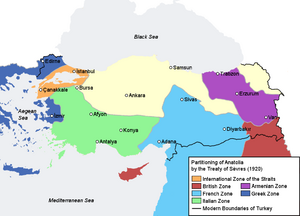
In 1914 Italy remained neutral and did not join its ally Germany in World War I. The Allies made promises and in 1915 Italy joined them. It was promised territorial spoils mainly from Austria and Turkey.[26]
في عام 1915، وافقت إيطاليا على دخول الحرب العالمية الأولى إلى جانب بريطانيا وفرنسا، وفي المقابل حصلت على ضمان في معاهدة لندن، بالحصول على أراضي في اوروبا، في حال نجحت بريطانيا وفرنسا في الاستيلاء على ممتلكات ألمانيا في أفريقيا.[27]
Prior to direct intervention in World War I, Italy occupied the Albanian port of Vlorë in December 1914.[28] In the fall of 1916, Italy started to occupy southern Albania.[28] In 1916, Italian forces recruited Albanian irregulars to serve alongside them.[28] Italy, with permission of the Allied command, occupied Northern Epirus on 23 August 1916, forcing the neutralist Greek Army to withdraw its occupation forces from there.[28] In June 1917, Italy proclaimed central and southern Albania as a protectorate of Italy while Northern Albania was allocated to the states of Serbia and Montenegro.[28] By 31 October 1918, French and Italian forces expelled the Austro-Hungarian Army from Albania.[28] However, in 1920, an Albanian rebellion led the Italians to agree to return the occupied regions to Albania, with the exception of Sazan Island.
Dalmatia was a strategic region during World War I that both Italy and Serbia intended to seize from Austria-Hungary. The Treaty of London guaranteed Italy the right to annex a large portion of Dalmatia in exchange for Italy's participation on the Allied side. From 5–6 November 1918, Italian forces were reported to have reached Lissa, Lagosta, Sebenico, and other localities on the Dalmatian coast.[29] By the end of hostilities in November 1918, the Italian military had seized control of the entire portion of Dalmatia that had been guaranteed to Italy by the Treaty of London and by 17 November had seized Fiume as well.[30] In 1918, Admiral Enrico Millo declared himself Italy's Governor of Dalmatia.[30] Famous Italian nationalist Gabriele D'Annunzio supported the seizure of Dalmatia, and proceeded to Zara (today's Zadar) in an Italian warship in December 1918.[31]
At the concluding Treaty of Versailles in 1919, Italy received less in Europe than had been promised and none overseas mandate except for a promise of colonial compensations made on 7 May 1919 during the partition of Germany's colonies between France and Britain. To satisfy this promise, France and Britain directly or indirectly gave Italy, from 1919 to 1935, a number of territories to expand Libya (Cufra, Sarra, Giarabub, the Aouzou strip, other lands in the Sahara), Somalia (Jubaland), the Dodecanese (Kastellorizo), and Eritrea (Raheita, the Hanish islands). In April 1920, it was agreed between the British and Italian foreign ministers that Jubaland would be Italy's first compensation from Britain, but London held back on the deal for several years, aiming to use it as leverage to force Italy to cede the Dodecanese to Greece.[32]
. . . . . . . . . . . . . . . . . . . . . . . . . . . . . . . . . . . . . . . . . . . . . . . . . . . . . . . . . . . . . . . . . . . . . . . . . . . . . . . . . . . . . . . . . . . . . . . . . . . . . . . . . . . . . . . . . . . . . . . . . . . . . . . . . . . . . . . . . . . . . . . . . . . . . . . . . . . . . . . . . . . . . . . .
الفاشية و"الامبراطورية الإيطالية" (1922–1940)

في عام 1922، أصبح زعيم الحركة الفاشية الإيطالية، بنيتو موسوليني رئيس لوزراء إيطاليا بعد حدوث انقلاب. موسوليني حل قضية السيادة على الجزر الاثنا عشرية في معاهدة لوزان عام 1923، التي أسبغت الشرعية على الادارة الإيطالية في كلٍ من ليبيا والجزر الإثنا عشرية، مقابل دفعة مالية إلى تركيا، خليفة الدولة العثمانية، بالرغم من فشله في محاولة استخلاص انتداب على جزء من العراق من بريطانيا.

Legend:
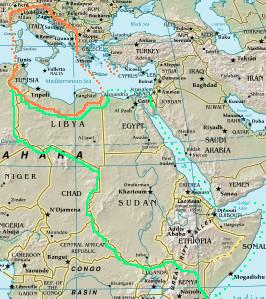

In 1922, the leader of the Italian fascist movement, Benito Mussolini, became Prime Minister and dictator. Mussolini resolved the question of sovereignty over the Dodecanese at the 1923 Treaty of Lausanne, which formalized Italian administration of both Libya and the Dodecanese Islands, in return for a payment to Turkey, the successor state to the Ottoman Empire, though he failed in an attempt to extract a mandate of a portion of Iraq from Britain.
The month following the ratification of the Lausanne treaty, Mussolini ordered the invasion of the Greek island of Corfu after the Corfu incident. The Italian press supported the move, noting that Corfu had been a Venetian possession for four hundred years. The matter was taken by Greece to the League of Nations, where Mussolini was convinced by Britain to evacuate Italian troops, in return for reparations from Greece. The confrontation led Britain and Italy to resolve the question of Jubaland in 1924, which was merged into Italian Somaliland.[33]
During the late 1920s, imperial expansion became an increasingly favoured theme in Mussolini's speeches.[34] Amongst Mussolini's aims were that Italy had to become the dominant power in the Mediterranean that would be able to challenge France or Britain, as well as attain access to the Atlantic and Indian Oceans.[34] Mussolini alleged that Italy required uncontested access to the world's oceans and shipping lanes to ensure its national sovereignty.[35] This was elaborated on in a document he later drew up in 1939 called "The March to the Oceans", and included in the official records of a meeting of the Grand Council of Fascism.[35] This text asserted that maritime position determined a nation's independence: countries with free access to the high seas were independent; while those who lacked this, were not. Italy, which only had access to an inland sea without French and British acquiescence, was only a "semi-independent nation", and alleged to be a "prisoner in the Mediterranean":[35]
The bars of this prison are Corsica, Tunisia, Malta, and Cyprus. The guards of this prison are Gibraltar and Suez. Corsica is a pistol pointed at the heart of Italy; Tunisia at Sicily. Malta and Cyprus constitute a threat to all our positions in the eastern and western Mediterranean. Greece, Turkey, and Egypt have been ready to form a chain with Great Britain and to complete the politico-military encirclement of Italy. Thus Greece, Turkey, and Egypt must be considered vital enemies of Italy's expansion ... The aim of Italian policy, which cannot have, and does not have continental objectives of a European territorial nature except Albania, is first of all to break the bars of this prison ... Once the bars are broken, Italian policy can only have one motto – to march to the oceans.
— Benito Mussolini، The March to the Oceans[35]
In the Balkans, the Fascist regime claimed Dalmatia and held ambitions over Albania, Slovenia, Croatia, Bosnia and Herzegovina, Vardar Macedonia, and Greece based on the precedent of previous Roman dominance in these regions.[36] Dalmatia and Slovenia were to be directly annexed into Italy while the remainder of the Balkans was to be transformed into Italian client states.[37] The regime also sought to establish protective patron-client relationships with Austria, Hungary, Yugoslavia, Romania, and Bulgaria.[36]
In both 1932 and 1935, Italy demanded a League of Nations mandate of the former German Cameroon and a free hand in Ethiopia from France in return for Italian support against Germany (see Stresa Front).[38] This was refused by French Prime Minister Édouard Herriot, who was not yet sufficiently worried about the prospect of a German resurgence.[38]

In its second invasion of Ethiopia in 1935–36, Italy was successful and it merged its new conquest with its older east African colonies to create Italian East Africa (إيطالية: Africa Orientale Italiana). On 9 May 1936 Mussolini proclaimed the establishment of the Italian Empire in East Africa ("l'Impero"), with King Victor Emmanuel III as Emperor of Ethiopia.[39] In 1939, Italy invaded Albania and incorporated it into the Fascist state. During the Second World War (1939–1945), Italy occupied British Somaliland, parts of south-eastern France, western Egypt and most of Greece, but then lost those conquests and its African colonies, including Ethiopia, to the invading allied forces by 1943. It was forced in the peace treaty of 1947 to relinquish sovereignty over all its colonies. It was granted a trust to administer former Italian Somaliland under United Nations supervision in 1950. When Somalia became independent in 1960, Italy's eight-decade experiment with colonialism had ended.
The Second Italo-Ethiopian War cost Italy 4,359 killed in action—2,313 Italians, 1,086 Eritreans, 507 Somalis and Libyans, and 453 Italian laborers.[40] Ethiopian military and civilian dead, many of them from Italian bomb and mustard gas attacks, were estimated as high as 275,000.[40]
In July 1936, Francisco Franco of the Nationalist faction in the Spanish Civil War requested Italian support against the ruling Republican faction, and guaranteed that, if Italy supported the Nationalists, "future relations would be more than friendly" and that Italian support "would have permitted the influence of Rome to prevail over that of Berlin in the future politics of Spain".[41] Italy intervened in the civil war with the intention of occupying the Balearic Islands and creating a client state in Spain.[42] Italy sought the control of the Balearic Islands due to its strategic position – Italy could use the islands as a base to disrupt the lines of communication between France and its North African colonies and between British Gibraltar and Malta.[43] After the victory by Franco and the Nationalists in the war, Italy pressured Franco to permit an Italian occupation of the Balearic Islands but he did not do so.[44]

After the United Kingdom signed the Anglo-Italian Easter Accords in 1938, Mussolini and foreign minister Ciano issued demands for concessions in the Mediterranean by France, particularly regarding Djibouti, Tunisia and the French-run Suez Canal.[45] Three weeks later, Mussolini told Ciano that he intended for Italy to demand an Italian takeover of Albania.[45] Mussolini professed that Italy would only be able to "breathe easily" if it had acquired a contiguous colonial domain in Africa from the Atlantic to the Indian Oceans, and when ten million Italians had settled in them.[34] In 1938, Italy demanded a sphere of influence in the Suez Canal in Egypt, specifically demanding that the French-dominated Suez Canal Company accept an Italian representative on its board of directors.[46] Italy opposed the French monopoly over the Suez Canal because, under the French-dominated Suez Canal Company, all Italian merchant traffic to its colony of Italian East Africa was forced to pay tolls on entering the canal.[46]
In 1939, Italy invaded and captured Albania and made it a part of the Italian Empire as a protectorate and separate kingdom in personal union with the Italian crown. The region of modern-day Albania had been an early part of the Roman Empire, which had actually been held before northern parts of Italy had been taken by the Romans, but had long since been populated by Albanians, even though Italy had retained strong links with the Albanian leadership and considered it firmly within its sphere of influence.[47] It is possible that Mussolini simply wanted a spectacular success over a smaller neighbour to match Germany's absorption of Austria and Czechoslovakia.[47] Italian King Victor Emmanuel III took the Albanian crown, and a fascist government under Shefqet Verlaci was established to rule over Albania.
الحرب العالمية الثانية (1940–1943)
دخل موسوليني الحرب العالمية الثانية إلى جانب أدولف هتلر بخطط لتكبير حيازات إيطالية الإقليمية. وكانت له مطامع في أجزاء من غرب يوغوسلاڤيا، جنوب فرنسا، كورسيكا، مالطة، تونس، جزء من الجزائر، وميناء على المحيط الأطلسي في المغرب، أرض الصومال الفرنسي ومصر والسودان البريطانيتين.[49] كما ذكر موسوليني لإيتالو بالبو طموحاته للاستيلاء على الممتلكات البريطانية والفرنسية في الكامرون وتأسيس الكامرون الإيطالي، أملاً في أن تؤسس إيطاليا مستعمرة على الساحل الأطلسي لأفريقيا.
. . . . . . . . . . . . . . . . . . . . . . . . . . . . . . . . . . . . . . . . . . . . . . . . . . . . . . . . . . . . . . . . . . . . . . . . . . . . . . . . . . . . . . . . . . . . . . . . . . . . . . . . . . . . . . . . . . . . . . . . . . . . . . . . . . . . . . . . . . . . . . . . . . . . . . . . . . . . . . . . . . . . . . . .
نهاية الإمبراطورية (1943–1960)
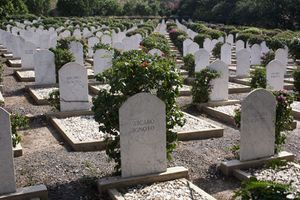
بحلول خريف 1943، كانت الامبراطورية الإيطالية (وكل أحلام إيطاليا العظمى) قد انتهت. By the autumn of 1943, the Italian Empire and all dreams of an Imperial Italy effectively came to an end. On 7 May, the surrender of Axis forces in Tunisia and other near continuous Italian reversals, led King Victor Emmanuel III to plan the removal of Mussolini. Following the Invasion of Sicily, all support for Mussolini evaporated. A meeting of the Grand Council of Fascism was held on 24 July, which managed to impose a vote of no confidence to Mussolini. The "Duce" was subsequently deposed and arrested by the King on the following afternoon. Afterwards, Mussolini remained a prisoner of the King until 12 September, when, on the orders of Hitler, he was rescued by German paratroops and became leader of the newly established Italian Social Republic.
After 25 July, the new Italian government under the King and Field Marshal Pietro Badoglio remained outwardly part of the Axis. But, secretly, it started negotiations with the Allies. On the eve of the Allied landings at Salerno, which started the Allied invasion of Italy, the new Italian government secretly signed an armistice with the Allies. On 8 September, the armistice was made public. In Albania, Yugoslavia, the Dodecanese, and other territories still held by the Italians, German military forces successfully attacked their former Italian allies and ended Italy's rule. During the Dodecanese Campaign, an Allied attempt to take the Dodecanese with the cooperation of the Italian troops ended in total German victory. In China, the Imperial Japanese Army occupied Italy's concession in Tientsin after getting news of the armistice. Later in 1943 the Italian Social Republic formally ceded control of the concession to Japan's puppet regime in China, the Reorganized National Government of China under Wang Jingwei.
In 1947, the Treaty of Peace with Italy formally ended the empire that was now totally defunct. There were discussions to maintain Tripolitania (a province of Italian Libya) as the last Italian colony, but these were not successful. In November 1949 the former Italian Somaliland then under British military administration, was made a 10-year United Nations Trust Territory under Italian administration (Trust Territory of Somaliland). On 1 July 1960, Somalia merged with British Somaliland to form the independent Somali Republic.
Former colonies, protectorates and occupied areas
- Italian Eritrea (1882–1947)
- Italian Somalia (1889–1947)
- Oltre Giuba (1924-1926)
- Trust Territory of Somaliland (1950–1960)
- Libya (1911–1947)
- Italian Tripolitania and Italian Cyrenaica (1911–1934)
- Italian Libya (1934–1943)
- Trans-Juba (1924–1926)
- Italian East Africa (1936–1941)
- Italian Ethiopia (1936–1941)
- Italian concessions in China
- Italian concession of Tientsin (1901–1943)
- Italian Albania (1917–1920, 1939–1943)
- Italian Islands of the Aegean (1912–1947)
- Italian occupation of France (1940–1943)
- Italian occupation of Corsica (1942-1943)
- Independent State of Croatia (1941–1945)
- Italian occupation of Montenegro (1941–1943)
- Hellenic State (1941–1943)
- Tunisia (1942–1943)
Notes
- ^ Total Italian, Eritrean, and Somali deaths, including those from disease, were estimated at 9,000.[20]
- ^ Nine Italian aircraft flew both combat and support missions during the campaign.[25] Furthermore, the Italian dirigibles P2 and P3 discover and make a highly effective bombing attack against Ottoman Army cavalry during a battle at Zanzur in the Italo-Turkish War, making an important contribution to the Italian Army's offense in this battle. History's first war death of a pilot occurred when an aircraft crashed during a recon sortie.[25]
معرض الصور
Massawa in 1890.
Italian mounted infantry in China during the Boxer Rebellion in 1900.
Mogadishu in 1936, with the Catholic Cathedral and the Triumphal Arch dedicated to Victor Emmanuel III.
Italian soldiers leaving for the Second Italo-Abyssinian War.
الملك ڤيكتور إمانويل الثالث في زيارة إلى بنغازي عام 1938.
انظر أيضاً
- إريتريا الإيطالية
- ليبيا الإيطالية
- الصومال الإيطالي
- إثيوپيون إيطاليون
- إريتريون إيطاليون
- صوماليون إيطاليون
- ليبيون إيطاليون
- شرق أفريقيا الإيطالية
- Luigi Amedeo, Duke of the Abruzzi
- Amedeo, 3rd Duke of Aosta
- ألبانيا تحت الحكم الإيطالي
- Dodecanese Campaign
- Concession in Tientsin
- جوبالاند
- Eritrean Ascari
- Trust Territory of Somalia
- إيطاليا العظمى
- Italian Africa Police
- Italian East African lira
المصادر
هوامش
- ^ Harrison, Mark (2000). The Economics of World War II: Six Great Powers in International Comparison. Cambridge University Press. p. 3. ISBN 9780521785037. Archived from the original on 16 أكتوبر 2016. Retrieved 2 أكتوبر 2016.
- ^ Soldaten-Atlas (Tornisterschrift des Oberkommandos der Wehrmacht, Heft 39). Leipzig: Bibliographisches Institut. 1941. p. 32.
- ^ Lowe, p.289
- ^ Betts (1975), p.12
- ^ Dubé, Jean-Claude (2005). The Chevalier de Montmagny (1601-1657): First Governor of New France. Translated by Elizabeth Rapley. University of Ottawa Press. pp. 263–287. ISBN 978-0-7766-0559-3.
- ^ Mifsud, A. (1914). "Attempts to reestablish the Tongue". Knights Hospitallers of the Ven. Tongue of England in Malta. AMS Press. p. 246. ISBN 9780404170097.
- ^ Betts (1975), p.97
- ^ Lowe, p.21
- ^ Lowe, p.24
- ^ Lowe, p.27
- ^ Storia Militare della Colonia Eritrea, Vol. I. Roma: Ministero della Guerra. 1935. pp. 15–16.
- ^ Mia Fuller, "Italian Colonial Rule", Oxford Bibliographies Online. Retrieved 12 October 2017.
- ^ Theodore M. Vestal, "Reflections on the Battle of Adwa and Its Significance for Today", in The Battle of Adwa: Reflections on Ethiopia's Historic Victory Against European Colonialism (Algora, 2005), p. 22.
- ^ Pakenham (1992), p.280
- ^ Pakenham, p.281
- ^ Killinger (2002), p.122
- ^ Pakenham, p.470
- ^ Killinger, p.122
- ^ Pakenham (1992), p.7
- ^ أ ب ت Clodfelter 2017, p. 202.
- ^ Barclay, Glen St John (1973). The rise and fall of the new Roman empire: Italy's bid for world power, 1890–1943. London. ISBN 9780283978623.
{{cite book}}: CS1 maint: location missing publisher (link) - ^ Italy’s Encounters with Modern China: Imperial Dreams, Strategic Ambitions, edited by Maurizio Marinelli and Giovanni Andornino, Palgrave Macmillan, 2014
- ^ Maurizio Marinelli, Self-portrait in a Convex Mirror: Colonial Italy Reflects on Tianjin [1]
- ^ Killinger (2002), p.133
- ^ أ ب ت Clodfelter 2017, p. 353.
- ^ Renzi, 1968.
- ^ Fry (2002), p.178
- ^ أ ب ت ث ج ح خطأ استشهاد: وسم
<ref>غير صحيح؛ لا نص تم توفيره للمراجع المسماةNigel Thomas 2001. Pp. 17 - ^ Giuseppe Praga, Franco Luxardo. History of Dalmatia. Giardini, 1993. Pp. 281.
- ^ أ ب Paul O'Brien. Mussolini in the First World War: the Journalist, the Soldier, the Fascist. Oxford, England, UK; New York, New York, USA: Berg, 2005. Pp. 17.
- ^ A. Rossi. The Rise of Italian Fascism: 1918–1922. New York, New York, USA: Routledge, 2010. Pp. 47.
- ^ Lowe, p.187
- ^ Lowe, pp. 191–199
- ^ أ ب ت Smith, Dennis Mack (1981). Mussolini, p. 170. Weidenfeld and Nicolson, London.
- ^ أ ب ت ث Salerno, Reynolds Mathewson (2002). Vital crossroads: Mediterranean origins of the Second World War, 1935–1940, pp. 105–106. Cornell University Press
- ^ أ ب Robert Bideleux, Ian Jeffries. A history of eastern Europe: crisis and change. London, England, UK; New York, New York, USA: Routledge, 1998. Pp. 467.
- ^ Allan R. Millett, Williamson Murray. Military Effectiveness, Volume 2. New edition. New York, New York, USA: Cambridge University Press, 2010. P. 184.
- ^ أ ب Burgwyn, James H. (1997). Italian foreign policy in the interwar period, 1918–1940, p. 68. Praeger Publishers.
- ^ Guida dell'Africa Orientale Italiana (in الإيطالية). Milano: CTI. 1938. p. 33.
- ^ أ ب Clodfelter 2017, p. 355.
- ^ Sebastian Balfour, Paul Preston. Spain and the Great Powers in the Twentieth Century. London, England, UK; New York, New York, USA: Routledge, 1999. P. 152.
- ^ R. J. B. Bosworth. The Oxford handbook of fascism. Oxford, UK: Oxford University Press, 2009. Pp. 246.
- ^ John J. Mearsheimer. The Tragedy of Great Power Politics. W. W. Norton & Company, 2003.
- ^ The Road to Oran: Anglo-French Naval Relations, September 1939 – July 1940. Pp. 24.
- ^ أ ب Reynolds Mathewson Salerno. Vital Crossroads: Mediterranean Origins of the Second World War, 1935–1940. Cornell University, 2002. p 82–83.
- ^ أ ب "French Army breaks a one-day strike and stands on guard against a land-hungry Italy", LIFE, 19 Dec 1938. Pp. 23.
- ^ أ ب Dickson (2001), pg. 69
- ^ Time Magazine Aosta on Alag?
- ^ Calvocoressi (1999) p.166
- CS1 maint: location missing publisher
- CS1 الإيطالية-language sources (it)
- Short description is different from Wikidata
- Articles with hatnote templates targeting a nonexistent page
- Missing redirects
- Articles containing إيطالية-language text
- Convert errors
- Pages using infobox country with unknown parameters
- Pages using infobox country or infobox former country with the flag caption or type parameters
- Sidebar using too many parameters
- مقالات بالمعرفة بحاجة لذكر رقم الصفحة بالمصدر from October 2021
- Articles with unsourced statements from June 2011
- استعمار
- الامبراطورية الإستعمارية الإيطالية
- فاشية إيطالية
- امبراطوريات وراء البحار
- التاريخ الحديث لإيطاليا



